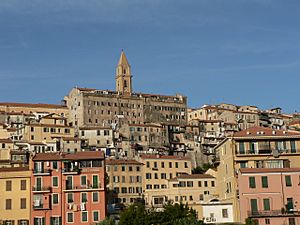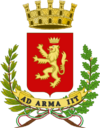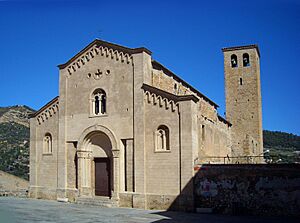Ventimiglia facts for kids
Quick facts for kids
Ventimiglia
|
|||
|---|---|---|---|
| Città di Ventimiglia | |||

Panorama of Ventimiglia
|
|||
|
|||
| Country | Italy | ||
| Region | Liguria | ||
| Province | Imperia (IM) | ||
| Frazioni | Grimaldi, Mortola Inferiore, Mortola Superiore (i Ciotti), Latte, Carletti, Sealza, Sant'Antonio, Villatella, Ville, Calandri, San Lorenzo, San Bernardo, Seglia, Bevera, Calvo, San Pancrazio, Torri, Varase, Roverino, Porra, Trucco, Verrandi | ||
| Area | |||
| • Total | 54.01 km2 (20.85 sq mi) | ||
| Elevation | 9 m (30 ft) | ||
| Population
(28 February 2017)
|
|||
| • Total | 24,120 | ||
| • Density | 446.58/km2 (1,156.6/sq mi) | ||
| Demonym(s) | Ventimigliesi | ||
| Time zone | UTC+1 (CET) | ||
| • Summer (DST) | UTC+2 (CEST) | ||
| Postal code |
18039
|
||
| Dialing code | 0184 | ||
| Patron saint | San Secondo | ||
| Saint day | 26 August | ||
Ventimiglia is a beautiful resort town in northern Italy. It is located in the province of Imperia, in the Liguria region. The town is about 130 kilometers (80 miles) west of Genoa.
It is also very close to the France-Italy border, only 7 kilometers (4 miles) away. Ventimiglia sits on the Gulf of Genoa. A small harbor is found at the mouth of the Roia River. This river divides the town into two main parts. About 55,000 people live in the Ventimiglia area.
Contents
What's in a Name?
The name Ventimiglia comes from an old name, Album Intimilium. This name changed over time to Albintimilium, then Vintimilium, and finally Ventimiglia.
It might sound like "twenty miles" in Italian (venti miglia). This is just a coincidence. However, the town was almost exactly 20 miles from France between 1388 and 1860.
A Look Back: Ventimiglia's History
Ventimiglia has a very long and interesting history. It was once called Album Intimilium. This was the main city for the Intimilii, an ancient tribe from the Ligurian region.
Early Challenges and Growth
In the 6th century, during the Gothic Wars, the city was attacked by the Byzantines and the Goths. Later, it faced raids from Rothari, who was the King of the Lombards. Despite these attacks, Ventimiglia grew and became strong again.
In the 10th century, the city was attacked by Saracen raiders. After this, Ventimiglia became an independent commune. This meant it governed itself. However, it often had to fight against the powerful Republic of Genoa.
Struggles with Genoa
In 1139, the Genoese attacked Ventimiglia by land and sea. They forced the city to give up. Even so, the local counts continued to rule the city. They became vassals, meaning they served the Genoese.
Ventimiglia tried to rebel against Genoa many times. It often joined Genoa's enemies. In 1271, during a war with Genoa, the city's leader, Luca Grimaldi, was captured.
The city was also held by the dukes of Savoy in 1389 and 1746. King Ladislaus of Naples also controlled it for a short time in 1410. In 1505, Ventimiglia officially became part of the Genoese Republic. It remained part of Genoa until the early 1800s.
The Lascaris Family
In 1269, a count from Ventimiglia, Guglielmo Pietro I Balbo, married Eudoxia Laskarina. She was the daughter of Emperor Theodore II Laskaris. This marriage started a new family line called the Lascaris of Tenda.
They ruled the independent County of Tenda until 1501. The last ruler from this family, Anne Lascaris, married Renato of Savoy. This marriage transferred the county to a different branch of the Savoy dynasty.
Exploring Ventimiglia's Main Sights
Ventimiglia has many interesting places to visit, showing its long history.
Roman Ruins and Ancient Discoveries
You can still see parts of a Roman theatre here. It was built in the first half of the 2nd century. Remains of other ancient buildings have also been found. These include parts of the old city walls. A beautiful mosaic was found in 1852, but it was sadly destroyed. Many tombs have also been discovered west of the theatre.
The ruins of the ancient city, Albintimilium, are located about 2 kilometers (1.2 miles) east of the modern town. They are in the plain of Nervia.
Prehistoric Caves
The caves of the Balzi Rossi are very important. They have provided many palaeolithic remains from the Quaternary period. This means they show evidence of very early human life. Skeletons of a Cro-Magnon family were found here. These included men, women, and children.
Historic Buildings and Churches
The old medieval city center is very important for its architecture and history. It sits on a hill overlooking the newer part of town.
The Church of San Michele Arcangelo was built in the 10th century. The Counts of Ventimiglia built it on the site of an old pagan temple. Later, Benedictine monks took care of it. In the 11th and 12th centuries, it was rebuilt in the Romanesque style. An earthquake in 1628 damaged its side sections. Inside, you can see old milestones from the ancient Via Iulia Augusta road. Two of these are used as stoups (holy water fonts). One even supports the ceiling of the crypt.
The main church, called the Romanesque Cathedral of the Assumption, is also very old. It has an 11th-century baptistery. This cathedral is built on the ruins of an earlier Lombard church. That church, in turn, was built on the site of a Roman building, possibly a temple. It is the main church for the Diocese of Ventimiglia-San Remo.
Gardens and Fortresses
The municipal library in Ventimiglia has a huge collection of 17th-century manuscripts and books. It's the second largest in Italy, after Venice.
The Giardini Botanici Hanbury are beautiful botanical gardens. They surround the villa of Sir Thomas Hanbury, called La Mortola. These are the largest gardens in Italy and among the best in Europe. They have many kinds of tropical and sub-tropical plants. These plants grow well here because of the mild climate.
Near Ventimiglia, you can also find old Genoese fortresses. These include Castel d'Appio, Forte San Paolo, and Fortezza dell'Annunziata.
Tourism and Travel
Ventimiglia is a popular place for tourists, especially in the summer. Many visitors come from the French Riviera.
A very popular event is the weekly street market, held every Friday. It takes place along the seafront of the new town. This market is very popular with visitors from France and can cause a lot of traffic.
Getting Around
Ventimiglia is located on the Via Aurelia Provincial Road. It also has an exit on the A10 Motorway.
The Ventimiglia railway station is an important connection point. It links the train line from Genoa to France with the line that goes to Cuneo.
International Connections
Ventimiglia has a special connection with Spain. There is a Royal Spanish honorary consulate in the town.
Sister Cities
Ventimiglia is twinned with:
See also
 In Spanish: Ventimiglia para niños
In Spanish: Ventimiglia para niños




